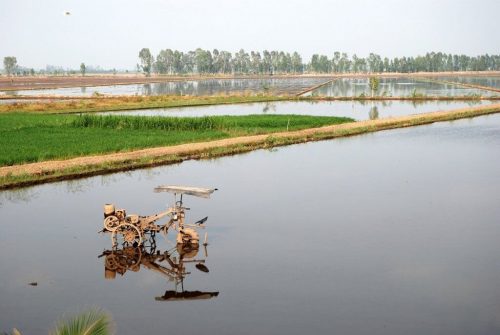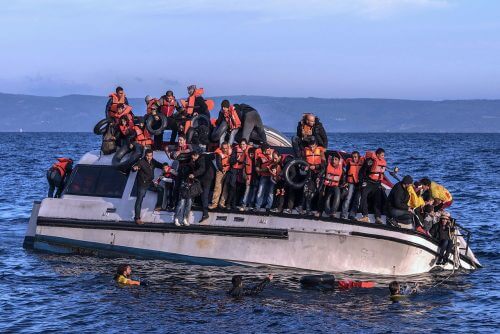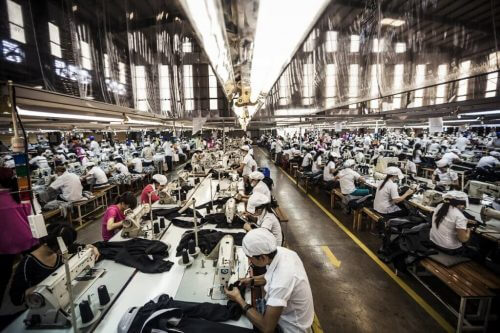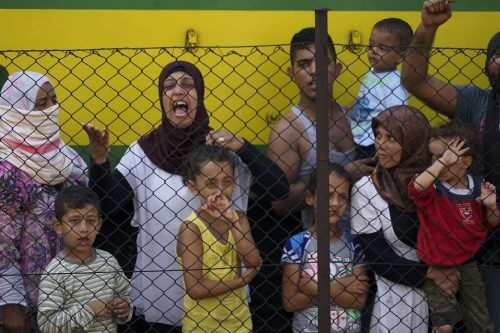From Vietnam's Door to the Not-So-Fertile Crescent, climate change is increasing the migration of communities to cities, igniting violent conflict, transforming economies and creating a new environment

By Ran Ben Michael, Angle, Science and Environment News Agency
The Mekong Delta area in Vietnam, where about 17 and a half million people live, is an agricultural area that mainly exports rice, seafood and orchard fruits. In the last decade, about a million people left it and the annual rate of emigration from it is double that of other areas in Vietnam. why? It is possible that the explanation for this can also be found in the negative effects of climate change on the region: houses that fell due to flooding and erosion of the coastline, the salinity of the water that does not allow traditional crops and also limits the possibility of trying new crops, frequent drought events, erosion of fertile soil, and also a change in the transport of The nutrients and sediment build the delta and enable the agricultural crops.
study In common with researchers from England and Vietnam who asked to check the yield of rice crops found that in 2013 (and again in 2016) in many districts at the mouth of the Mekong the yield was almost zero mainly due to the intrusion of salty water and drought - both phenomena whose frequency is related to the climate crisis.
These are mainly the weakest strata of the population who have no choice, due to climate change, to leave their homes, often to other places within the country. Government statistics in Vietnam show that one in a hundred residents left the area immediately after the difficult years for farmers in the last decade; One can perhaps assume that the real numbers are even greater.
Projects that exacerbate the injury
The movement of people on the globe is part of human history and the reasons for it are many; Part of voluntary migration and part of displacement due to disaster or forced deportation. In many cases it is a human tragedy that does not find an answer in the places of origin, the intermediate stations or the final destinations. Awareness of migration or displacement due to environmental circumstances has been increasing in recent years and has found expression, for example,in a statement New York of the September 2016 UN conference, which emphasized environmental changes as driving factors for migration. for example, study A local from Van Lang University in Ho Chi Minh City found that the most significant cause of migration is escaping poverty and looking for more lucrative occupations, and that there is a connection between environmental effects, some of which are related to climate change, and the migration decisions of about 14 percent of the residents of the Mekong Delta.
A similar phenomenon occurs in many deltas around the world. River delta areas around the world are highly fertile and densely populated mainly by farmers who are often impoverished and destitute. The deltas are inherently exposed to the effects of climate change, such as sea level rise, and this leads to demographic changes. מצרים, for example, promises, in its declaration of commitment in accordance with the Paris Agreement (INDC), that the rise of the sea level will affect low-lying areas and the delta of the Nile and that it must develop capabilities to deal with these changes and their impact on the rural population, including through internal migration.
Sometimes the attempt to solve the problem creates a vicious and discouraging circle: a team of researchers called DECMMA Examining three deltas in Africa and Asia in recent years, he found that the damage in these areas worsens precisely with the development of dealing with climate change. Many times the authorities initiate projects of adaptation to the changing conditions to help the residents who are affected by them. The adaptation strategies can be a change in land use or building infrastructure, but a lack of knowledge and uninformed choices have meant that the resilience of the communities in these places is low. This fact increases their vulnerability and thus accelerates the processes of unplanned migration. For example, a huge system of dams built in the Mekong to prevent flooding of brackish water blocks the passage of nutrients that form the basis of food for fish and agricultural crops and thus harms farmers.
Migration to the city is sometimes the result of a personal-family decision and sometimes, as mentioned, because of the motivation of the communities as part of a deliberate policy. A comparative study of the European Union-funded International Organization for Migration sees controlled migration as an underutilized tool in adaptation policy - Despite the tendency to think of migration in negative terms, it has positive contributions on a personal level and in that it may indeed help vulnerable populations deal with climate change, at least in the sense of saving lives.

Dr. Michal Nachmani, research fellow at the Grantham Institute for Climate Change and the Environment at the London School of Economics, who focuses on In a comparative examination of climate change legislation around the world Explains that climate change adaptation policy is one of the most complex problems facing decision makers - beyond the uncertainty and the required long planning horizon, the issues extend across many fields; They require many government ministries and organizations (agriculture, water, housing and development, health, industry, interior, etc.) and different levels of government (national, regional, local). "For the most part, climate change is not treated as a holistic problem, but as a specific problem - such as flood prevention," says Nachmani. "Planned migration is one of the solutions to the complex problem of sea level rise or the loss of coastal sources of income, but the same ministries of agriculture no longer deal with what is happening with the uncontrolled urbanization of those who are no longer poor farmers in the village and are now poor workers in the city. In order to be able to prevent further damage caused by unplanned migration - efforts must be combined between all planning and implementation factors."
The effect of environmental pressures
Where do these new climate migrants who are forced to leave the rural areas where they used to live go? According to Data The World Bank has increased the share of the world's urban population since the middle of the 20th century from about 34 percent to 54 percent. Even in Israel, which has always been a predominantly urban society, the relative share increased from 77 percent to 92 percent during this period. Israeli urbanism may not be related to climate change, and even worldwide the move to the city depends on the local context of political, economic, social and family factors - but it is reasonable to assume that migration due to climate change is also expected to be One of the factors that will accelerate the urbanization process in the coming decades; Migration from rural areas to cities is a worldwide phenomenon with one in every 200 residents of these areas moving to the city each year.
Although in the city there is a promise of economic well-being and a reduced environmental threat, it does not always materialize and the nature of the vulnerability of the communities changes. In 2050, more than two-thirds of the world's population is expected to live in the cities But even today these infrastructures are lacking to sustainably support the growth of the population. The environmental problems - air pollution, water availability, energy consumption, waste treatment, light and noise pollution, and loss of land for real estate - are intensifying and the problem of climate change is simply being relocated. Urban resilience strategies must now be developed to cope; An adaptation policy that concerns only one side of the process will probably be insufficient.
Immigration also does not always yield the sought-after economic solution, and the cities cannot provide a socio-economic infrastructure to deal with the increase in the proportion of the poor among them. For example, in Ulaanbaatar, the capital of Mongolia, poor suburbs have grown in the garbage dumps around the city with tens of thousands of immigrants who fled the drought in the countryside. Another indication that the economic contribution of immigration to the city is not high is the increase in economic inequality; Report Shared by a number of UN organizations on the state of food security and nutrition for 2017 stated that a large part of the global decline in food security is directly related to the worsening of violent struggles around the world that are sometimes intensified following extreme situations related to climate change.
Sew environmental damage

Although there is not enough data on the subject, it is desirable to examine additional consequences of climate migration on the environment, not only due to the process of urbanization, but also due to the changes at the hands of the immigrants. Vietnam, for example, is the fifth largest exporter of clothing in the world - it has about 6,000 factories employing almost three and a half million Company Staff And as of 2016, it exports clothes with a value of about 28 billion dollars, which is expected to grow to about 50 billion in the year 2020.
This industry is mainly part of what is known as "fast fashion", which is characterized by the low price of items and the rapid turnover of collections. Fast fashion has מחיר Huge environmental - water consumption and pollution, use of toxic chemicals, industrial waste and billions of items that fill landfills and more; Textile dyes are the second largest water pollutant in the world and tiny fibers of polyester, the common material in industry, are probably one of the main elements in the pollution of microplastics in the oceans. The clothes may be enjoyed by the end customers, but a significant part of the environmental damage remains in the producing country or is spread around the world with the transport and sea currents.
The low price of fast fashion clothes is made possible in no small part by the cheap and available labor force created by immigration to the big cities in Vietnam. Thus, instead of agriculture that produces and exports food and that deals intelligently with climate change, the former farmers support an industry that has a lot of environmental damage. One of the challenges of adaptation policy in general, and the one that concerns the well-being of humans in particular, is indeed the ability to deal with many variables such as these.
The drought and the civil war in Syria
Climate migration has even more difficult sides. The explosive combination of protracted and violent sectarian conflict and the effects of climate change have combined to create mass migration during Syria's ongoing and bloody civil war. Since March 2011, the influx of refugees and displaced people in the region has reshaped the geopolitical map in the region. The main reason for the civil war is of course the rule of the Alawite minority under the leadership of the dictator Bashar al-Assad who responded with severe violence to the demands of the 'Arab Spring' of his citizens; The internal social fragmentation and external interventions created a complicated system of factions that fight each other to this day. However, significant environmental factors also contributed to the internal pressure and led to the explosion in Syria. A drought that lasted from 2006 to 2010 (the worst in the Fertile Crescent until then) sent millions of farmers migrating to cities in search of new economic opportunity. They did this when food in the country is becoming more expensive due to dwindling supply and the cities are already full of refugees from Iraq. In the absence of an agricultural and environmental policy in the country, the political instability in Syria continued to deteriorate.

study from 2014 indicates that man-made climate change is the most likely cause of the deterioration of the water economy in the Middle East region. After at least ten years of warnings and alerts, that year the US Department of Defense acknowledged that climate change will limit access to food, water and electricity, reduce economic activity and increase the spread of disease. The causal link between the climate crisis and the civil war in Syria is not direct, but it is likely that it added to the bubbling local pressure pot: A review study of the National Bureau of Economic Research, an American think tank, found in 2014 that climate change increases the likelihood of the development of conflicts, both interpersonal and intergroup.
These are examples of how the socio-ecological system responds to the changes occurring in it. To illustrate, we can go back to Vietnam where we started: decades ago a process began in the cultivation of mangrove trees, partly in the estuaries of the Mekong Delta, in order to develop seafood aquaculture farms. The developing country's venture may have been financially successful, but the delta has become more vulnerable and less resistant to climate change, which has only gotten worse since then. Attempts to adapt - both in local projects and in immigration - entail other difficulties and may even accelerate climate change in turn. This indicates that not only "nature" is out of balance, the global socio-economic system is also going wrong together with the ecological system.
Regarding the development of legislation and policy in the field, Dr. Nachmani predicts that "the social and economic consequences of climate change are among the enormous challenges of our generation, and they will not stop in developing countries. It is already clear that human and environmental stresses flow uncontrollably outside the source of the stress. In addition to what has been obvious until now, that greenhouse gas emissions must be reduced in order to reduce climate change, adaptation policy must now be treated seriously and holistically and the biggest challenge in this area is a challenge of governance. Recognizing the complexity of the problem, and careful and interdisciplinary planning, may reduce the huge damages that are already affecting us."
